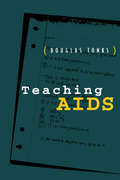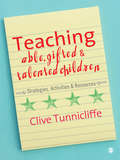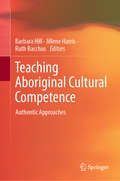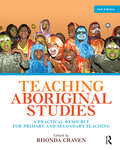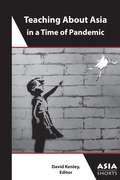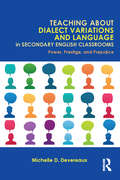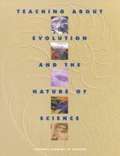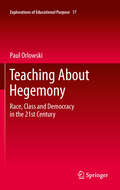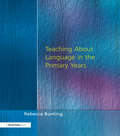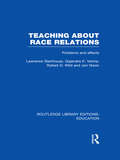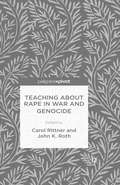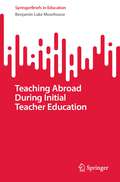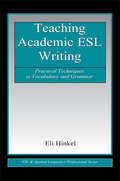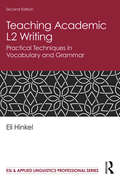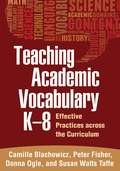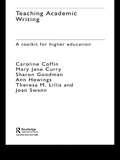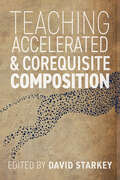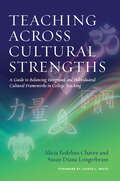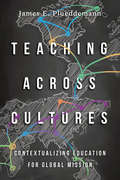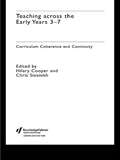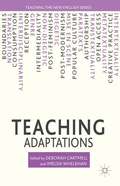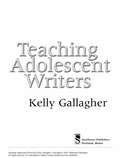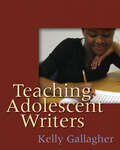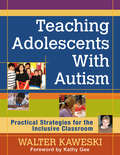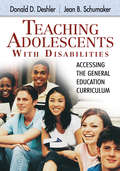- Table View
- List View
Teaching AIDS
by Douglas TonksTeaching AIDS begins with a discussion of how teachers can create an environment of support for an AIDS education programme. Recognizing that AIDS education must differ for students of different age groups, the author presents tailored, age-appropriate content - what and how teachers should communicate AIDS information to young children, older children and teenage students.Teaching AIDS also addresses actual methods teachers can use to influence their students' attitudes and behaviour by helping them to recognize problem situations in which risks might arise, and presenting them with the actual skills they need to protect themselves in such situations.
Teaching Able, Gifted and Talented Children: Strategies, Activities & Resources
by Clive TunnicliffeClive Tunnicliffe offers a vision of provision for able, gifted and talented (AG&T) learners within the context of Every Child Matters (ECM) legislation and the drive to achieve personalised learning. Providing a clear and concise summary of an increasingly important area of educational provision, this book offers the right balance of theory and practical strategies. There is advice on: - developing a whole school policy for AG&T provision - defining and identifying AG&T learners - strategies to use in the classroom - developing critical and creative thinking - out-of-school enrichment activities - supporting AG&T learners - working with parents Each chapter contains a summary of key points, case studies of good practice, great ideas to use with students and Professional Development Activities for staff. This book is short enough to be a quick read, but there is much to whet your appetite for finding out more about this fascinating area of teaching and learning. It is a useful and interesting resource for busy managers, project leaders, classroom practitioners and learning support staff across the primary and secondary age range. Clive Tunnicliffe is an education consultant currently based in China; he had a long career in the UK as a teacher, Local Authority Advisor, National Strategy Manager and Director of Publications for NACE.
Teaching Aboriginal Cultural Competence: Authentic Approaches
by Barbara Hill Jillene Harris Ruth BacchusThis book examines a collaborative partnership model between academia and Indigenous peoples, the goal of which is to integrate Indigenous perspectives into the curriculum. It demonstrates how the authentic and creative approaches employed have led to an evolution of curriculum and pedagogy that facilitates cultural competence among Australian graduate and undergraduate students. The book pursues an interdisciplinary approach based on highly practical examples, exemplars and methods that are currently being used to teach in this area. It focuses on facilitating student acquisition of knowledge, understanding, attitudes and skills, following Charles Sturt University’s Cultural Competence Pedagogical Framework. Further, it provides insights into the use of reflective practice in this context, and practical ideas on embedding content and sharing practices, highlighting examples of potential “ways forward,” both nationally and globally.
Teaching Aboriginal Studies: A practical resource for primary and secondary teaching
by Rhonda CravenTeaching Aboriginal Studies has been a practical guide for classroom teachers in primary and secondary schools, as well as student teachers, across Australia. Chapters on Aboriginal history and culture, stereotypes and racism, government policies and reconciliation provide essential knowledge for integrating Aboriginal history and culture, issues and perspectives across the curriculum.This second edition of Teaching Aboriginal Studies encompasses developments over the past decade in Aboriginal affairs, Aboriginal education and research. It features a wide range of valuable teaching sources including poetry, images, oral histories, media, and government reports. There are also strategies for teaching Aboriginal Studies in different contexts and the latest research findings. The text is lavishly illustrated with photographs, posters, paintings, prints, ads and cartoons.Teaching Aboriginal Studies is the product of consultation and collaboration across Australia. Remarkable educators and achievers, both Aboriginal and other Australians, tell what teachers need to know and do to help Aboriginal students reach their potential, educate all students about Aboriginal Australia and make this country all that we can be.'The importance of this book cannot be overestimated. We have been insisting for years that pre-service teachers be required to learn about Aboriginal history, culture and identity, and that it be regarded as integral to qualifying for their education degrees.' Lionel Bamblett, General Manager, Victorian Aboriginal Education Association Inc.
Teaching About Asia in a Time of Pandemic (Asia Shorts)
by David KenleyIn the spring of 2020, educators suddenly found themselves teaching remotely as they and their students began a multiweek period of pandemic-induced isolation. As weeks turned to months, administrators announced that students would not return to campus until the following school year and perhaps even longer. Teachers quickly scrambled to design new pedagogical approaches suitable to a socially-distanced education.Teaching About Asia in a Time of Pandemic presents many lessons learned by educators during the COVID-19 outbreak. The volume consists of two sections. Section one includes chapters discussing how to teach Asian history, politics, culture, and society using examples and case studies emerging from the pandemic. Section two focuses on the pedagogical tools and methods that teachers can employ to teach Asian topics beyond the traditional face-to-face classroom. Both sections are designed for undergraduate instructors as well as high school teachers using prose that is easily accessible for non-specialists. The volume is a collaborative work between the AAS Asia Shorts series and the AAS pedagogical journal Education about Asia, exemplifying the high standards of both publishing ventures.
Teaching About Dialect Variations and Language in Secondary English Classrooms: Power, Prestige, and Prejudice
by Michelle D. DevereauxStandardized tests demand Standard English, but secondary students (grades 6-12) come to school speaking a variety of dialects and languages, thus creating a conflict between students’ language of nurture and the expectations of school. The purpose of this text is twofold: to explain and illustrate how language varieties function in the classroom and in students’ lives and to detail linguistically informed instructional strategies. Through anecdotes from the classroom, lesson plans, and accessible narrative, it introduces theory and clearly builds the bridge to daily classroom practices that respect students’ language varieties and use those varieties as strengths upon which secondary English teachers can build. The book explains how to teach about language variations and ideologies in the classroom; uses typically taught texts as models for exploring how power, society, and identity interact with language, literature, and students’ lives; connects the Common Core State Standards to the concepts presented; and offers strategies to teach the sense and structure of Standard English and other language variations, so that all students may add Standard English to their linguistic toolboxes.
Teaching About Evolution And The Nature Of Science
by Joyce L. Vedral National Academy of Sciences Staff Working Group on Teaching EvolutionToday many school students are shielded from one of the most important concepts in modern science: evolution. In engaging and conversational style, Teaching About Evolution and the Nature of Science provides a well-structured framework for understanding and teaching evolution.Written for teachers, parents, and community officials as well as scientists and educators, this book describes how evolution reveals both the great diversity and similarity among the Earth's organisms; it explores how scientists approach the question of evolution; and it illustrates the nature of science as a way of knowing about the natural world. In addition, the book provides answers to frequently asked questions to help readers understand many of the issues and misconceptions about evolution.The book includes sample activities for teaching about evolution and the nature of science. For example, the book includes activities that investigate fossil footprints and population growth that teachers of science can use to introduce principles of evolution. Background information, materials, and step-by-step presentations are provided for each activity. In addition, this volume:-- Presents the evidence for evolution, including how evolution can be observed today.-- Explains the nature of science through a variety of examples.-- Describes how science differs from other human endeavors and why evolution is one of the best avenues for helping students understand this distinction.-- Answers frequently asked questions about evolution.Teaching About Evolution and the Nature of Science builds on the 1996 National Science Education Standards released by the National Research Council--and offers detailed guidance on how to evaluate and choose instructional materials that support the standards.Comprehensive and practical, this book brings one of today's educational challenges into focus in a balanced and reasoned discussion. It will be of special interest to teachers of science, school administrators, and interested members of the community.
Teaching About Hegemony
by Paul OrlowskiPolitical progressives in Canada and the United States are deeply concerned by the manner in which their countries treat their poor. They are dismayed at the dismantling of the social welfare state, the weakening of public education systems and the grotesque and ever-growing inequality of wealth. To remedy this problem, citizens need to be more aware of how political ideology influences attitudes and actions, and they need to better comprehend the effects of hegemonic discourses in the corporate media and school curriculum. This book informs educators how to develop context-specific pedagogy that will help achieve a more enlightened citizenry and, as a result, a stronger democracy. Teaching about Hegemony: Race, Class and Democracy in the 21st Century promotes a progressive agenda for teaching that is rooted in critical pedagogy, it explains why ideological critique is necessary in raising political consciousness, it deconstructs white, middle-class hegemony in the formal school curriculum, and it examines corporate media and school curriculum as hegemonic devices. It also covers recent theory and research about race, class and democracy and how best to teach about these topics. Combining theory and sociological research with pedagogical approaches and classroom narratives, this book is fundamental for progressive educators interested in developing a politically conscious, progressive and active citizenry hungry for a stronger civil society.
Teaching About Language in the Primary Years
by Rebecca BuntingFirst Published in 2001. Routledge is an imprint of Taylor & Francis, an informa company.
Teaching About Race Relations: Problems and Effects (Routledge Library Editions: Education)
by Robert Wild Jon Nixon Gajendra Verma Lawrence StenhouseThis is the report of two linked research projects: the SSRC Project on Problems and Effects of Teaching about Race Relations, and the Calouste Gulbenkian Foundation Project on Teaching About Race Relations through Drama. Its aim is to help teachers who will face race as a theme, whether it arises in the normal course of their subject teaching or is introduced as a separate topic. The project worked with three groups of teachers, each of which adopted a different approach, and the results of the testing programme are given alongside a series of case studies of classroom teaching. The book includes a summary of the findings of the research, express as hypotheses and an account of the teacher-dissemination of the project’s work; it concludes with reflections by the director of the project and a participant teacher.
Teaching About Rape in War and Genocide
by John K. Roth Carol RittnerThis edited volume is both a guide for educators and a resource for everyone who wants to strengthen resistance against a major atrocity that besieges human development. Its contributors explore a crucial question: how to teach about rape in war and genocide?
Teaching Abroad During Initial Teacher Education (SpringerBriefs in Education)
by Benjamin Luke MoorhouseThis book explores teaching abroad during initial teacher education, an increasingly common practice in the initial preparation of teachers. Teaching abroad involves pre-service teachers spending a defined period teaching in a foreign country or in an alternative, and preferably a distinctly different, education system from the one in which they are receiving their initial teacher education. The book, drawing on relevant literature and the author’s first-hand experience of developing and leading a teaching-abroad project, is a concise but comprehensive introduction to the field. Important aspects of the initiative, such as rationale, project designs, benefits, criticisms and limitations, community considerations and future possibilities are included. The book is an important starting point for teacher educators interested in developing teaching abroad projects, as well as academics and scholars interested in the principles, practices, and debates around teaching abroad in initial teacher education.
Teaching Academic ESL Writing: Practical Techniques in Vocabulary and Grammar (ESL & Applied Linguistics Professional Series)
by Eli HinkelTeaching Academic ESL Writing: Practical Techniques in Vocabulary and Grammar fills an important gap in teacher professional preparation by focusing on the grammatical and lexical features that are essential for all ESL writing teachers and student-writers to know. The fundamental assumption is that before students of English for academic purposes can begin to successfully produce academic writing, they must have the foundations of language in place--the language tools (grammar and vocabulary) they need to build a text. This text offers a compendium of techniques for teaching writing, grammar, and lexis to second-language learners that will help teachers effectively target specific problem areas of students' writing. Based on the findings of current research, including a large-scale study of close to 1,500 non-native speakers' essays, this book works with several sets of simple rules that collectively can make a noticeable and important difference in the quality of ESL students' writing. The teaching strategies and techniques are based on a highly practical principle for efficiently and successfully maximizing learners' language gains. Part I provides the background for the text and a sample of course curriculum guidelines to meet the learning needs of second-language teachers of writing and second-language writers. Parts II and III include the key elements of classroom teaching: what to teach and why, possible ways to teach the material in the classroom, common errors found in student prose and ways to teach students to avoid them, teaching activities and suggestions, and questions for discussion in a teacher-training course. Appendices to chapters provide supplementary word and phrase lists, collocations, sentence chunks, and diagrams that teachers can use as needed. The book is designed as a text for courses that prepare teachers to work with post-secondary EAP students and as a professional resource for teachers of students in EAP courses.
Teaching Academic L2 Writing: Practical Techniques in Vocabulary and Grammar (ESL & Applied Linguistics Professional Series)
by Eli HinkelThe new edition of this comprehensive text fills an important role in teacher professional preparation by focusing on how to teach the grammar and vocabulary that are essential for all L2 writing teachers and student-writers. Before L2 writers can begin to successfully produce academic prose, they need to understand the foundations of the language and develop the language tools that will help them build reasonable quality text. Targeting specific problem areas of students’ writing, this text offers a wealth of techniques for teaching writing, grammar, and vocabulary to second-language learners. Updated with current research and recent corpus analysis findings, the second edition features a wealth of new materials, including new teaching activities; student exercises and assignments; and substantially revised appendices with supplementary word and phrase lists and sentence components. Designed for preservice ESL/ELT/TESOL courses as well as Academic Writing and Applied Linguistics courses, this book includes new, contextualized examples in a more accessible and easy-to-digest format.
Teaching Academic Vocabulary K-8
by Camille Blachowicz Donna Ogle Susan Watts Taffe Peter FisherThis book showcases effective ways to build the vocabulary knowledge K-8 learners need to engage meaningfully in reading, writing, and discussion on academic subjects. The distinguished authors draw on decades of classroom experience to explain what academic vocabulary is, how it fits into the Common Core State Standards, and how targeting vocabulary can enhance conceptual understanding in English language arts, social studies, and math and science. Rich classroom vignettes, teaching tips, and examples of student work are included. The book also features helpful figures, word lists, discussion questions, and recommended print and online resources.
Teaching Academic Writing: A Toolkit for Higher Education (Literacies Ser.)
by Joan Swann Mary Jane Curry Caroline Coffin Ann Hewings Sharon Goodman Theresa LillisStudent academic writing is at the heart of teaching and learning in higher education. Students are assessed largely by what they write, and need to learn both general academic conventions as well as disciplinary writing requirements in order to be successful in higher education.Teaching Academic Writing is a 'toolkit' designed to help higher education lecturers and tutors teach writing to their students. Containing a range of diverse teaching strategies, the book offers both practical activities to help students develop their writing abilities and guidelines to help lecturers and tutors think in more depth about the assessment tasks they set and the feedback they give to students. The authors explore a wide variety of text types, from essays and reflective diaries to research projects and laboratory reports. The book draws on recent research in the fields of academic literacy, second language learning, and linguistics. It is grounded in recent developments such as the increasing diversity of the student body, the use of the Internet, electronic tuition, and issues related to distance learning in an era of increasing globalisation.Written by experienced teachers of writing, language, and linguistics, Teaching Academic Writing will be of interest to anyone involved in teaching academic writing in higher education.
Teaching Accelerated and Corequisite Composition
by David StarkeyTeaching Accelerated and Corequisite Composition is the first book to compile on-the-ground advice and teaching strategies specifically curated for accelerated and corequisite writing courses. Trailblazers in the field from colleges across the United States—who developed a foundation for corequisites by facilitating equity and accessibility for marginalized students—speak to a range of topics and demographics, offering support for instructors and practical advice for improving student success. The book primarily explores accelerated composition through the lens of two-year colleges to answer a central question in the field: to what extent do educators need to alter two-year college curricular design? The contributors also delve into assessment, a crucial process for instructors and their students transitioning to accelerated learning; the key role that reading plays in the writing process; and noncognitive learning, an area of study that has been associated with accelerated learning since its inception. Together these thirteen chapters provide instructors with a strategic approach to teaching accelerated and corequisite composition. Teaching Accelerated and Corequisite Composition points toward a new way of approaching first-year composition: a method of instruction that fosters the growth and success of writers who were once considered underprepared for college writing and are now achieving unprecedented success.
Teaching Across Cultural Strengths: A Guide to Balancing Integrated and Individuated Cultural Frameworks in College Teaching
by Alicia Fedelina Chávez Susan Diana LongerbeamCo-published with Promoting learning among college students is an elusive challenge, and all the more so when faculty and students come from differing cultures. This comprehensive guide addresses the continuing gaps in our knowledge about the role of culture in learning; and offers an empirically-based framework and model, together with practical strategies, to assist faculty in transforming college teaching for all their students through an understanding of and teaching to their strengths.Recognizing that each student learns in culturally influenced ways, and that each instructor’s teaching is equally influenced by her or his background and experiences, the authors offer an approach by which teachers can progressively learn about culture while they transform their teaching through reflection and the application of new practices that enrich student learning.The key premise of the book is that deepening student learning and increasing retention and graduation rates requires teaching from a strengths based perspective that recognizes the cultural assets that students bring to higher education, and to their own learning. Derived through research and practice, the authors present their Model of Cultural Frameworks in College Teaching and Learning that highlights eight continua towards achieving the transformation of teaching, and developing more culturally balanced and inclusive practices, over time. They present techniques – illustrated by numerous examples and narratives – for building on cultural strengths in teaching; offer tips and strategies for teaching through cultural dilemmas; and provide culturally reflective exercises. This guide is intended for all faculty, faculty developers or administrators in higher education concerned with equitable outcomes in higher education and with ensuring that all student cultural groups learn and graduate at the same rates.
Teaching Across Cultures: Contextualizing Education for Global Mission
by James E. PlueddemannIn our globalized world, educators often struggle to adapt to the contexts of diverse learners. In this practical resource, educator and missiologist James Plueddemann offers field-tested insights for teaching across cultural differences. He unpacks how different cultural dynamics may inhibit learning and offers a framework for integrating conceptual ideas into practical experience.
Teaching Across the Early Years 3-7: Curriculum Coherence and Continuity
by Hilary Cooper Chris SixsmithThis practical and accessible book explores ways of developing continuity and coherence in children's learning from three to seven years old. It is based around three case studies in which tutors on Initial Teacher Training courses worked with early years practitioners in three different pre-school settings, each linked to a primary school. The book describes how they successfully managed to plan and teach integrated themes across the age-range in the context of the requirements of the Foundation Stage and the National Curriculum.Each case study has a different focus:* science, design and technology*' the arts' - including an ICT strand* 'the humanities' - including a physical education strandEnglish and mathematics dimensions run through each theme.The book is alive with discussion of children's art, language, drama and music, captured as field notes, writing, drawing, and as video tape. Each chapter concludes with suggestions of ways in which readers can develop the ideas in their own contexts.This book will be invaluable reading for students on Early Years courses, Early Years practitioners, and tutors and mentors in early childhood education.
Teaching Adaptations
by Deborah Cartmell Imelda WhelehanTeaching Adaptations addresses the challenges and appeal of teaching popular fiction and culture, video games and new media content, which serve to enrich the curriculum, as well as exploit the changing methods by which English students read and consume literary and screen texts.
Teaching Adolescent Writers
by Kelly GallagherIn an increasingly demanding world of literacy, it has become critical that students know how to write effectively. From the requirements of standardized tests to those of the wired workplace, the ability to write well, once a luxury, has become a necessity. Many students are leaving school without the necessary writing practice and skills needed to compete in a complex and fast-moving Information Age. Unless we teach them how to run with it, they are in danger of being run over by a stampede—a literacy stampede. In Teaching Adolescent Writers, Kelly Gallagher, author of Reading Reasons and Deeper Reading, shows how students can be taught to write effectively. Kelly shares a number of classroom-tested strategies that enable teachers to: - understand the importance of teaching writing; - motivate young writers; - see the importance modeling plays in building young writers (modeling from both the teacher and from real-world text); - understand how providing choice elevates adolescent writing (and how to allow for choice within a rigorous curriculum); - help students recognize the importance of purpose and audience; - assess essays in ways that drive better writing performance. Infused with humor and illuminating anecdotes, Kelly draws on his classroom experiences and work as co-director of a regional writing project to offer teachers both practical ways to incorporate writing instruction into their day and compelling reasons to do so.
Teaching Adolescent Writers
by Kelly GallagherIn an increasingly demanding world of literacy, it has become critical that students know how to write effectively. From the requirements of standardized tests to those of the wired workplace, the ability to write well, once a luxury, has become a necessity. Many students are leaving school without the necessary writing practice and skills needed to compete in a complex and fast-moving Information Age. Unless we teach them how to run with it, they are in danger of being run over by a stampede—a literacy stampede. InTeaching Adolescent Writers , Kelly Gallagher shows how students can be taught to write effectively. Gallagher shares a number of classroom-tested strategies that enable teachers to: Understand the importance of teaching writing and how to motivate young writers Show how modeling from both the teacher and real-world texts builds young writers Provide choice of what to write, which helps elevate adolescent writing, and how to fit it into a rigorous curriculum Help students recognize the importance of purpose and audience Assess essays in ways that drive better writing performance. Infused with humor and illuminating anecdotes, Gallagher draws on his classroom experiences and work as co-director of a regional writing project to offer teachers both practical ways to incorporate writing instruction into their day and compelling reasons to do so.
Teaching Adolescents With Autism: Practical Strategies for the Inclusive Classroom
by Walter G. KaweskiReaching teens with autism requires knowledge and heart Award-winning educator Walter Kaweski offers secondary teachers practical strategies and heartfelt insights based on his extensive experience as an inclusion coordinator and father of a son with Asperger syndrome. Students with special needs often require extra support as they adjust to adolescence. This book offers hundreds of valuable ideas to help teachers: Understand autism Solve adolescent behavior challenges Help students adjust to social situations Implement academic and behavioral interventions This unique resource takes the mystery out of autism and inspires teachers to appreciate the individuality of each student.
Teaching Adolescents With Disabilities: Accessing the General Education Curriculum
by Don Deshler Jean SchumakerAligned with the Individuals with Disabilities Education Act and No Child Left Behind Act requirements, this comprehensive guide empowers teachers and administrators with research-validated practices and interventions that can close the general-curriculum performance gap and break down the barriers to academic success for middle and high school students with disabilities. This insightful resource features: Practical planning advice, teaching practices, and learning strategies for inclusive classrooms Methods for designing instructional materials Tips for effectively leveraging technology Strategies for transition beyond high school Real-life examples and illustrations
